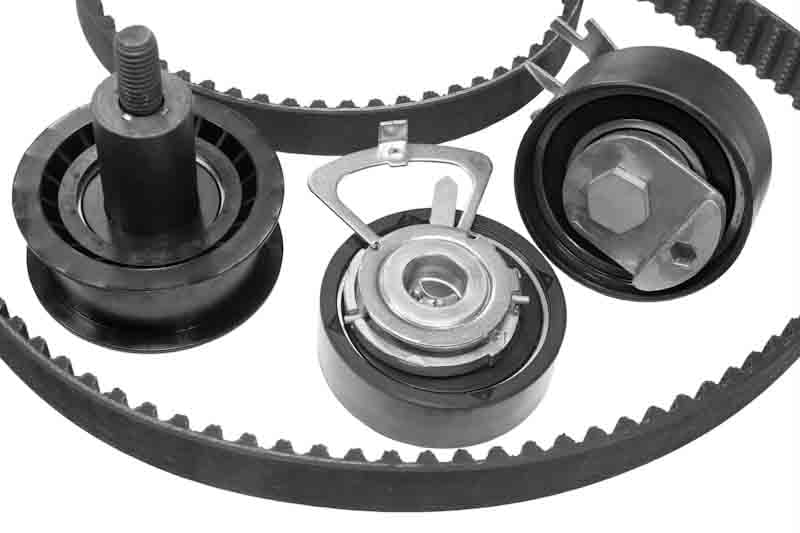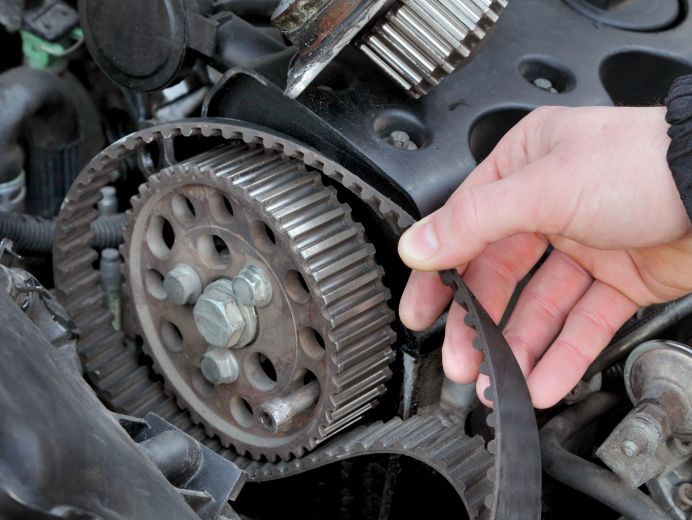Owning a vehicle can come with many challenges, but knowing when your cambelt needs replacing is important.
This guide gives you all the vital information relating to cambelts.
Car maintenance is a vital part of owning a vehicle, so having this information to hand will save you time and money.
What is a cambelt?
A cambelt is a critical component for an internal combustion engine. It is a long, thin belt made of rubber or synthetic material that is driven by the engine’s crankshaft and connects to the camshaft.
The camshaft controls the opening and closing of the engine’s valves, controlling the air-fuel mixture that enters and is expelled from the engine. Without a cambelt, your engine would not run properly.
As the engine ages, and is driven for more miles, the belt may become stretched, frayed or even snap. This is why it’s important to check the belt regularly for signs of wear and tear.
At your annual MOT, your mechanic will not check your cambelt. However, if you ask your local mechanic to check the cambelt at the annual service then they should inform you of any problems.
If the belt is worn, it should be replaced to ensure that the engine continues to run properly. Replacement is typically recommended every 60,000 to 100,000 miles, but some vehicle manufacturers may suggest the belt is changed when the vehicle reaches five or six years of age (which means the belt will need to be changed before the mileage limit).
However, this can vary due to the make and model of the vehicle.
A damaged cambelt can lead to further, serious damage to the rest of the vehicle, resulting in costly repairs and potential engine failure.
Car troubles?
Book a diagnostic test with us today. RAC Mobile Mechanics will check your car for faults, talk you through any repairs you might need, and give you a report for your records.


What is a timing belt?
In short, a timing belt is the same thing as a cambelt.
Cambelt is the common name for the item in the UK – but in other parts of the world it is known as a timing belt.
In some other countries, there may be a slight difference, due to the timing belt being described as a smaller version of a cambelt.
What does a cambelt do?
A cambelt controls the timing of a vehicle’s internal combustion engines between when the valves to the engine cylinders open and close. This controls the follow of air in and out of the engine.
For this to work correctly, the crankshaft and the camshaft most rotate in a synchronised way.
The cambelt is a rubber belt that has teeth which are designed to grip onto the cogs on the crankshaft and camshafts, which keeps them in sync.
Without the cambelt, the engine would not be able to function properly.
Service, repair or MOT?
You can trust the RAC with our local approved garages and NEW mobile mechanics.


Cambelt change
Over time, your cambelt will have general wear and tear – and will need to be replaced. In more serious situations, where it snaps or another issue causes it to break, it can be quite dangerous.
Knowing how and when to change your cambelt is an important part of owning a vehicle.
Signs of cam belt failure
The cambelt is a vital component of a petrol or diesel vehicle. If it fails it could result in catastrophic damage to the engine. This is why it is important to look out for the 5 signs of cambelt failure.
- Engine misfire: if your vehicle is misfiring then it may indicate the cambelt has a problem, which is affecting the engine combustion cycle
- Poor idling: a damaged cambelt or grip tooth can result in poor engine timing, which can make the vehicle stutter or judder when idling
- Unusual noises: if you can hear rattling, squeaking or ticking from the engine then it may indicate the cambelt has a problem. All of these sounds can be symptoms of a slipping cambelt
- Difficulty starting the engine: a broken cambelt will prevent the engine from starting. However, if your car is struggling to start, it may indicate the engine is running out of sync due to a problem with the belt
- Belt is cracked or frayed: if the cambelt appears cracked or damaged then it’s important to get it changed. Also look for any lost grip teeth on the underside of the belt, as these can result in the belt becoming loose or slipping
If you’re experiencing any of these symptoms, it’s important to have your vehicle checked as soon as possible by a qualified mechanic.

RAC sale – up to 33% off*
• Roadside cover from £5.49 a month*
• We get to most breakdowns in 60 mins or less
• Our patrols fix 4/5 breakdowns on the spot

When should a cambelt be changed and how often?
The replacement interval for your car's cambelt will be detailed in the owner's manual for the vehicle. This will be after a specific number of years or miles, whichever comes first.
Cambelt replacement can be set after 5 of 6 years or every 60,000 to 100,000 miles.
The important thing to remember is that it is checked every year during your annual service. The mechanic will give you an update on its condition and if it looks like it might need replacing.
To determine the exact replacement schedule for your vehicle, consult your owner’s manual or contact your local mechanic.
If any damage is present, the cambelt should be replaced immediately in order to avoid costly engine damage.
How much is a cambelt change?
Depending on the make, model, and how old the vehicle is, the cost to replace a cambelt can range a lot.
The parts can cost on average between £200 to £700. However, due to the nature of how to fix or replace a cambelt, the labour costs could mean that the end bill could be more than £1000.
Labour costs are also highly variable and depend on the complexity of the job and the time it takes to complete the work. Some garages charge a flat fee for the cambelt change, while others charge an hourly rate.
Regardless of the cost, it’s important to have a cambelt change done at the manufacturer’s recommended interval.
Source: whocanfixmycar, April 2025
| Manufacturer | Average replacement cost |
|---|---|
| Audi | £540 |
| BMW | £1031 |
| Citroen | £561 |
| Ford | £677 |
| MINI | £808 |
| Mercedes | £822 |
| Nissan | £644 |
| Peugeot | £537 |
| Renault | £519 |
| Toyota | £547 |
| Vauxhall | £608 |
| Volkswagen | £519 |
What happens when your cambelt goes?
There are several things you will notice if your cambelt goes. Initially you will notice strange noises from the engine along with a loss of power.
The engine will likely overheat, and you will notice smoke coming from your engine.
Stop the car immediately and either contact a mechanic or your breakdown provider.
Cambelt kit
The cambelt kit, is a collection of parts needed to fix or replace your cambelt or timing belt.
Below is an image of what you can expect, including the belt itself, the wheels where the belt spins round – as well as the tools that keep it all in place.

Cam chains
A cam chain is very similar to a cambelt, but the main difference being is that the chain is made out of metal.
Similar to a standard push bike gear chain, it operates in the same way, and is an integral part of keeping an engine running smoothly.
They need to be kept very lubricated in order to work properly – and can be equally as expensive to replace if the worst should happen.
Looking after your vehicle is an important part of daily life – and staying on top of its maintenance is something all car owners should be doing regularly.
If you think there is something wrong with your cambelt – or any other part of the vehicle – visit a trusted, local garage who can help get to the bottom of the issue.
Cambelt FAQs
- What are the signs of cambelt failure?
There are a few signs of to look out for if your cambelt is failing. If the belt is worn or damaged, it can cause the engine’s timing to be off, leading to misfiring.
You may also hear a ticking or squeaking sound from the engine can indicate that the cambelt or associated components are failing. This can also lead to overheating in the engine.
Drivers will also notice a decrease in engine performance or power can signal a problem with the cambelt. There may also see oil leaking near the cover under the cambelt housing.
The most obvious sign will the warning light illuminating on the dashboard.
- How much is a cambelt replacement?
According to whocanfixmycar, the average cost to replace a cambelt is around £645. This includes parts and labour.
However, this price can vary on a number of factors, including the make and model of the vehicle – and the quality of the new cambelt.
- What happens when your cambelt goes?
When a cambelt fails, it can lead to serious engine damage. The belt is responsible for keeping the camshaft and crankshaft in sync. If it breaks, the engine timing is thrown off, which can lead to stalling.
- When should a cambelt be changed?
The recommended interval for changing a cambelt can vary depending on the vehicle make and model, but generally, it’s advised to replace it every 40,000 to 100,000 miles.
Always refer to your vehicle’s owner’s manual for specific recommendations regarding cambelt replacement.












